"We're sensorily deprived right now in modern life. Our eyes are engaged--sometimes our ears--but our bodies? Not so much. These aren't just bags of bones we're carrying around." -- Michael Pollan in Lucky Peach no. 6.Smoked ham hock rillettes. This one might be a hard sell, not because making a few jars is particularly difficult but because--there's no point in trying to hide it--it's messy and time-consuming, a real process as far as a recipe goes. You cannot but get your hands (and your kitchen) dirty. But that's also what I enjoy about making them.
You might roll your eyes. Grad student. Too much time on her hands. But that's not what this comes down to. On weeknights, I'm all for ease and convenience, for meals that practically cook themselves and hardly leave a trace. But those aren't the meals that draw me to the kitchen. They're not the reason I cook. I cook to engage myself, to use my hands, to make messes and learn a thing or two in the midst of making them. These aren't, of course, the most basic reasons for being in the kitchen, but they are the ones that make cooking a pleasure, whatever night of the week it may be. And it's good, I think, to remind ourselves of this once in a while and cook something demanding, something that draws us in. And these rillettes, they do that.
Rillettes traditionally are a coarse-textured, rich spread made from a fatty cut of pork, duck, or goose. The meat is gently braised, finely shredded, and then mixed with fresh herbs, spices, and the flavourful liquid in which it was braised. Pretty straightforward. The result is something like pâté but less fussy. These particular rillettes, however, come from the good people at Mission Street Food and so, unsurprisingly, part with tradition.
The hock is pretty lean as far as cuts of pork go. In fact, it's mostly skin, bone, and connective tissue. So that's where things start to get messy with these rillettes. Once the hocks have been cooked, you need to get at what little meat there is. And there's no getting around this, you need to use your hands. Bits of meat are often tangled up with connective tissue and hard to spot, so what you need to do is break down the hocks by hand and feel your way through them, pulling soft tissue from bone, picking out the meat as you go.
But why use smoked hocks in the first place, why go through all that trouble for so little? Because what smoked hocks lack in flesh and fat they make up for in flavour and collagen. Remember all of that skin, that sticky connective tissue? Even after four hours of simmering, these are still steeped through with woodsy, smoky flavour. And just as important, they're rich in collagen. Collagen is all about texture. It's basically what gelatin is made out of. It's the stuff that gives homemade stocks their satiny, rich mouth-feel. So, naturally, that skin and connective tissue don't go to waste here. You whirl them in the blender with a splash of stock from cooking the hocks and push that through a sieve. And there you have it, smoky gelatin purée.
Now, this, I think, is where things get demanding. It isn't that anything gets difficult. It's just that your attention, your judgement is called for. You have to engage. Let me explain. At this point, you'll have all of your components lined up. From the hocks, you'll have meat, pork stock, and gelatin purée. You should also have some rendered pork fat (yes, lard) on hand to supplement what you have, since ham hocks are so lean. Then there are the seasonings. Quatre épices, a blend of white pepper, nutmeg, cinnamon, and clove, is traditional. Crushed garlic, dijon mustard, sherry vinegar, and fresh thyme leaves aren't out of place either. Salt, needless to say, is important. (As printed, the MSF recipe is loosey-goosey. Very helpfully, it calls for 'spices'.) The meat goes into the bowl of your stand mixer fitted with the paddle attachment. What happens next is more or less up to you. Each of the components will contribute a particular flavour and/or texture to the finished rillettes. How you prioritize them is a matter of preference. What this means is that you have to taste and tweak as you go. You have to ask yourself: does this need more fat? Is it getting too dry--should I add some stock? Could it use more acidity, more vinegar, maybe? Like I said, you have to engage. And little by little, you'll get to something that pleases you, that makes you beam.
So what I like about making these rillettes is that it's very physical, very involving. It's all about you feel and what you taste. This is no dump-and-stir exercise. There's no crossing your fingers, hoping that things have turned out. How things go is on you. It's a little scary, for sure. But it's also utterly liberating. I don't cook like this very often. I lean a lot on good cookbooks, regimented quantities. And on most days, that's all I feel I have the time for. But once in a while, I think, this is just the sort of thing you need to do.
Smoked Ham Hock Rillettes
Adapted from the Mission Street Food Cookbook
Note: About the seasoning. I stuck with fairly traditional seasonings, but you shouldn't feel limited to these. Look at other rillettes recipes for guidance. It'll be hard to go wrong. For example, I flat-out forgot to add mustard. My feeling is that juniper might be a nice addition. About the pork fat. There's no need to spring for anything as fancy as leaf lard for these rillettes. Save the good stuff for pies. But do take the trouble to find yourself some good, unprocessed fat. Try your favourite butcher. About the quantity of hocks. I got away with using just over 3 lbs of hocks but only because one of them was extra meaty. It would probably be wiser to use closer to 4 or 5 lbs. Shelf life. Sterilizing your jars will help the rillettes keep for longer in the fridge. Both Nigel Slater and Jane Grigson advise pouring a layer (half an inch or so) of melted pork fat over the rillettes if you're not planning on eating them within a few days.
3-5 lbs meaty smoked ham hocks (see above)
2.5-3 quarts chicken stock, pork stock, dashi, or water
1-2 cups rendered bacon or pork fat, plus more to cover (see above)
2 tablespoons or so sherry vinegar
1 tablespoon thyme leaves
1 1/2 tablespoons or so quatre épices
1 large clove garlic, crushed
Salt
Gently simmer the ham hocks in the chicken stock, pork stock, dash, or water.
After about 4 hours, the meat should be very tender. Cool the entire pot until you can handle the hocks. Drain and reserve the stock. (At the end you'll have plenty of stock left for cooking greens, or just for sipping.)
Pick the ham hocks apart by hand. Separate the meat from the skins and soft collagen. Reserve both. (The edges of the ham hocks can become dried out and tough from the smoking process or from not being fully submerged in liquid. Move the hocks around periodically as they simmer, and discard any parts that may be too tough to rillette. Discard any tough skin, bones, and weird gristle.)
Blend the skins and collagen with just enough stock to get the mix going (probably about 1/4-1/2 cup), creating a gelatin purée. Strain the purée through a fine sieve, using a lade or spoon to push it through.
Combine the meat and some of the purée, fat, vinegar, and spices in a stand mixer. (The ratios of fat-to-meat-to-gelatin will vary, depending on how you prioritize richness (fat), unctuousness (gelatin), and moisture (stock). Taste as you mix; add the salt, vinegar, mustard, and your spices, herbs, or garlic until you reach the desired balance.) Mix using the medium-low setting and the paddle attachment of your mixer. For best results, mix the rillettes at the temperature it will be served.
Store in glass or ceramic jars and chill in the fridge until ready to serve. Serve with good bread, pickles, a sharp salad, or even some tart fruit preserves. Consider stuffing any that remains in baked potatoes, as Nigel Slater suggests.
(In addition to the ham-hock stock, there'll be lots of leftover gelatin purée, which you can use to enrich anything from meatballs to gravy. If you're not quite ready to jump into another meat-centric project, it's okay to freeze the purée for later use.)
Serves 12-16 as an appetizer. (Fills about four 200 g jars.)

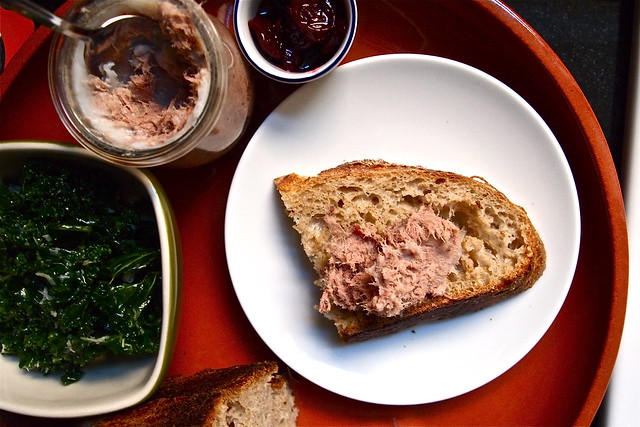

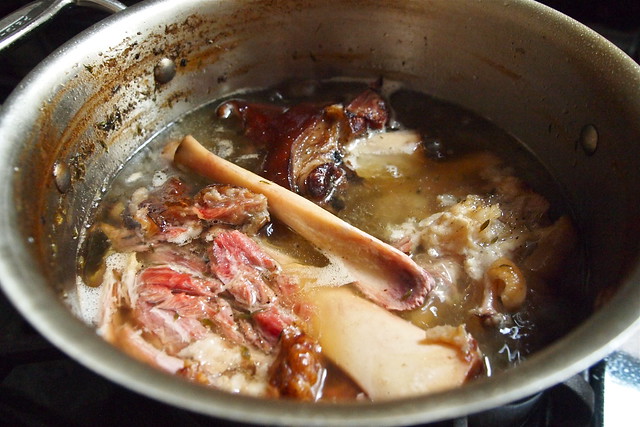
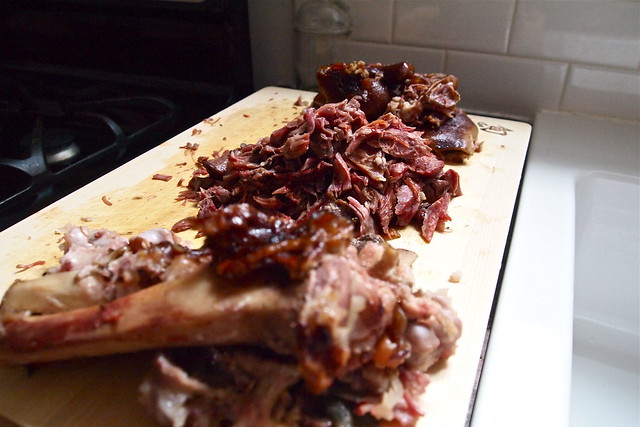
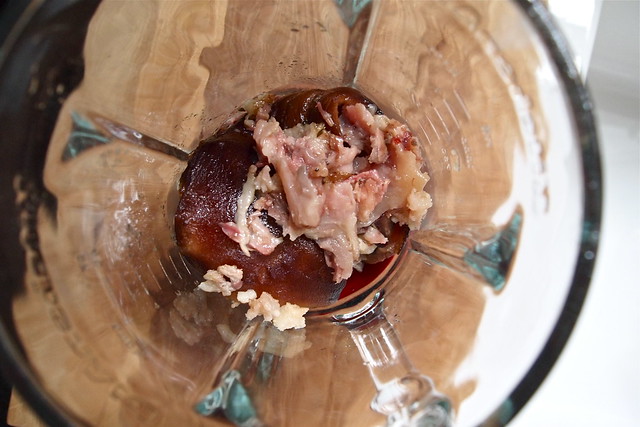

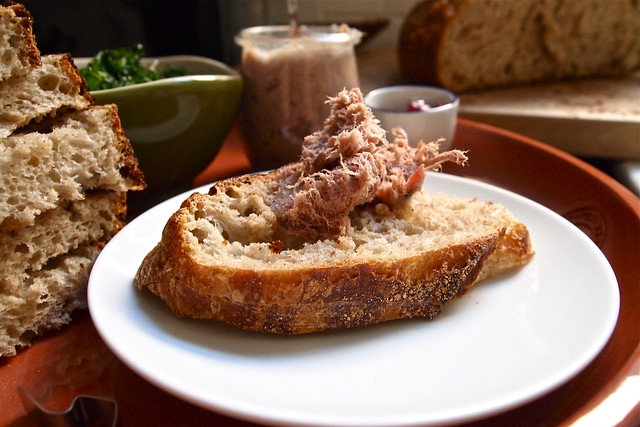
Wow! This is some exciting stuff, Katie. I know what you mean about really actively and extensively cooking to produce something special. I think most of the time I get in the practical mentality that food is for feeding and why glorify something so humble as a dinner (hence why I get into simple vegetarian things or bake-and-dump baked goods). But this is good. Definitely right about it being a little scary too! I've always appreciated how you get into a lot of "projects" on your blog.
ReplyDeleteDefinitely, Amy. Just cooking for yourself and not giving in and ordering pizza is a struggle sometimes! I don't think I ate nearly as well as you seem to when I was still an undergrad. I guess I've just been thinking a lot lately about the food I write about here and why these messier, more involved projects are important to me. Cooking can be a chore on some nights, but oddly enough, I think, it can be the more demanding things we cook that renew our interest in it.
DeleteAWESOMEAWESOMEAWESOMEAWESOMEAWESOMEAWESOMEAWESOMEAWESOMEAWESOMEAWESOMEAWESOMEAWESOMEAWESOMEAWESOMEAWESOME!!!!! There's nothing I don't love about this; the subject matter, the poetic advice, the great photos that make me drool, and the rillettes themselves. So great!
ReplyDeleteThanks, Allen. That means a lot, considering all the crazy-beautiful stuff that comes out of your kitchen.
DeleteCreating something complex and nuanced from simple ingredients is what makes cooking such an essential part of my life! It's recipes like this, that seem to, through some alchemy, utterly transform simple ingredients into something so very much greater than the sum of their parts. Magic.
ReplyDeleteTotally gorgeous pictures, Katie! Also, Andrew and I ate all our already, on whole grain toast with spicy bread and butter pickles. Absolutely decadent.
ReplyDeleteHa! I was going to email Andrew about the rillettes-stuffed baked potatoes in case you guys had any left. We made some last night for dinner, and I have to say, rillettes make for a mighty fine baked potato.
DeleteLove love your blog :-) How lucky I am to find it!
ReplyDeleteThis rilletes looks absolutely fantastic! I wish I could eat it with my sourdough bread RIGHT NOW.
Not only do I love this recipe, but I also love the way you talk about food: how we "need to engage," and how we have become sensorily deprived. I love a good food project that requires that I'm all in-- needing to focus completely and dedicated a good amount of space to the thing I'm creating. It looks like time very well spent.
ReplyDeleteI spend so much of my day at a desk, and while that can be engaging in its own way, I do look forward to getting my hands dirty. And so do you, by the looks of your blog! I would love to go foraging for nettles, though I'm not sure I'd know where to start.
DeleteLove the looks of this recipe! What timing! Just happen to have pork stock simmering since yesterday.....and a bag of smoked hocks in the freezer so I will certainly be trying this one sometime this week!
ReplyDeleteAh, it's great when that happens. I'd love to know how the rillettes turn out for you!
DeleteHurray, finally a food blog that is not just about cupcakes and quick pasta/vegetable dishes. This looks great!
ReplyDelete